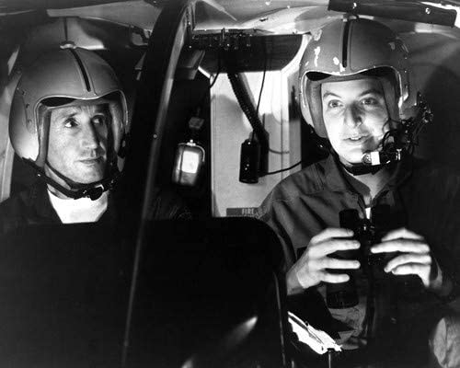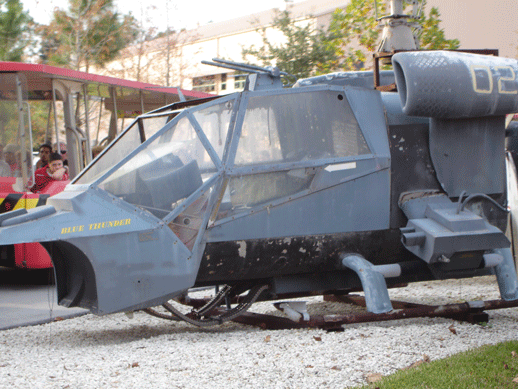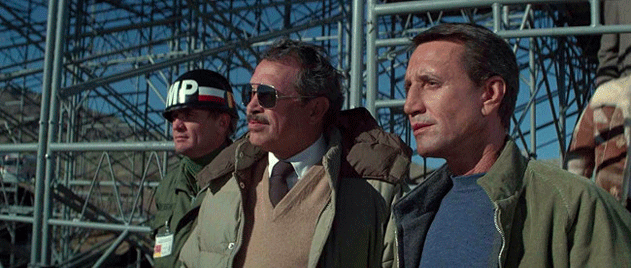The L.A. cops in Blue Thunder are some of the worst I’ve ever seen. On their first night of duty, officers Frank Murphy (Roy Scheider) and his rookie partner Lymangood (Daniel Stern) of the helicopter division abuse their power to peep on a woman doing nude yoga in the privacy of a large studio apartment, solving, or potentially exacerbating, exactly one crime.

It’s a far cry from Buddy Russo, the New York cop Scheider made famous twelve years earlier in The French Connection, but it’s also a suitable indictment of police — both past and present.
The crime they do witness serves as the inciting action of the film; a black L.A. councilwoman is murdered by an apparent burglar in her home. In the course of their investigation, Murphy and Lymangood find that she was killed just before she could blow the whistle on the very experimental helicopter they were testing for the force.
Scheider and Stern had been handpicked to test-fly an “advanced” helicopter known as Blue Thunder that the military is loaning out. Scheider is the last person who should be tasked with this, as his character Frank Murphy is an over-the-hill Vietnam vet plagued with PTSD flashbacks. It would be the equivalent of bringing John Rambo home and giving him his own personal tank.
Blue Thunder opens with a text scroll, informing the audience that the technology used in the movie is very real.
The helicopter was one of the film’s key selling points, spoken of at length in the press material. It is currently residing at Disney’s Hollywood Studios and can be seen on the backlot tour. There’s no other air vehicle like it, having been composed of parts from French Gazelles and Apache helicopters — and without Hollywood, it probably wouldn’t fly with all the alterations made. Many of the more impressive stunts were radio-controlled.
Black helicopters are mainly the stuff of urban legend and conspiracy theory, tied to everything from aliens to cattle mutilations. While their use, or even existence in some cases, is hard to prove, there are some accounts of government agencies using black helicopters to surveil and patrol domestically.

If there’s one thing that’s abundantly clear, it is the militarization of police in America. Particularly as the titular year of George Orwell’s oft-referenced 1984 approached, black helicopters were the perfect metaphor to explore a city where racial tension would explode only nine years later.
The use of black helicopters specifically may be the stuff of legend, but the militarization of police and the ability to spy on citizens — especially since the Patriot Act — are concerns directly related to the United Nations Sustainable Development Goal on Peace, Justice, and Strong Institutions.
It is perhaps worth understanding why helicopters were introduced to Los Angeles in the first place. The Air Support Division was founded in 1956 with just one chopper in the sky. Today, it is the largest aerial division in the country, with nineteen helicopters. At least two are in the air at all times, weather permitting.
The city is spread out over 500 square miles, so helicopters seem logical, except Los Angeles residents have been deeply concerned about their privacy. According to Melissa Hamilton, JD, Ph.D., they should be.
“There is mostly anecdotal evidence of domestic police departments systemically using aerial surveillance. The reason we don’t know much more is that there is no public reporting mechanism for the use of such technology. Still, there is case law on the subject.”
The Supreme Court’s previous rulings seem to support this. We have no expectation of privacy if a cop observes what we do from a helicopter or an airplane.
A spec script written by Dan O’Bannon and Don Jakoby, Blue Thunder was conceived while they were living in L.A., where they would be woken by Los Angeles Air Support Division helicopters overhead. Jakoby started writing, and the project turned into what O’Bannon described as Taxi Driver in a helicopter.
There’s little doubt that Blue Thunder had some influence on a more well-known cop film. The scene in which the Blue Thunder is introduced is a less graphic version of the famed ED-209 scene in Robocop four years later, with the helicopter indiscriminately machine-gunning paper targets of hostages and terrorists alike. Murphy grins knowingly throughout.
The Blue Thunder is a threat without the guns. With a whisper mode and crystal clear recording capability, it’s the perfect spy vehicle. With enough of them, Murphy mutters, “You could run the whole d*mn country.”
Murphy has a history with one of the program’s top pilots, Cochrane, played by Malcolm McDowell. The two served in Vietnam together, during which Murphy witnessed Cochrane shoot a civilian out of a helicopter. Not long after testing the Blue Thunder, Murphy and Lymangood use it to spy on their superiors, uncovering the truth about the murdered councilwoman.
With the increasingly unstable and now betrayed Vietnam vet having nowhere to turn, Scheider steals the Blue Thunder. O’Bannon’s original draft had him rain hellfire down on Los Angeles, as previously seen on paper targets, using the Blue Thunder as it was originally conceived.
First Blood had a similar ending. The novel ended with Rambo ultimately getting gunned down by his former Colonel, and the film softened this by having Stallone force him to pull the trigger; but Hollywood wasn’t ready to kill a bankable lead, or to make him homicidal.
Blue Thunder’s ending is unquestionably a compromise to save face — and it hurts. Scheider spends a lot of time in the air, certainly posing a threat but not harming civilians. Lives are certainly in jeopardy, some real estate is destroyed, but only those who deserve it die.
It’s still an impressive machine, and Badham almost uses it to full fascist effect. Ultimately, though, the studio felt Murphy snapping was “non-commercial”, according to O’Bannon.
Not that O’Bannon’s vision ever had a chance at being made in 1984. To receive access to LAPD and military equipment, as well as technical advisors, the Los Angeles Police had full authority to tear anything out of the script they found problematic.
It is perhaps most telling that the LAPD was okay with their officers being portrayed as having a potentially dangerous mental condition or as peeping toms.
O’Bannon compromised — he wrote good LAPD officers and bad feds. They couldn’t have cast the roles better. As Scheider’s aging, good-natured commanding officer, Warren Oates is an absolute delight. Oates, a legend of Sam Peckinpah westerns and offbeat hits like Two-Lane Blacktop, died just a month after filming wrapped. It’s the kind of role any actor would want as their last.
Equally good in the opposite role is McDowell (who was terrified of flying), who oozes cockiness and smarm while serving a formidable threat to Scheider.

After starring in Jaws and The French Connection, Scheider didn’t take the path most Hollywood actors did at the birth of the blockbuster. He was tempted with the Jaws sequel and the offer of continuing the franchise in the third, to which he responded that “Mephistopheles himself” could not have made him accept.
Instead, Scheider’s late-70s and 80s are overloaded with films that are only starting to be appreciated now - John Frankenheimer’s 52 Pickup, Robert Benton’s Still of the Night and William Friedkin’s remake of The Wages of Fear, Sorcerer. Blue Thunder fits in nicely.
Blue Thunder’s popularity spawned a TV spinoff with James Farentino and a young Dana Carvey. It lasted one season.
Are there still concerns about strange helicopter activity over Los Angeles? Just this January, a military training operation made the news and caught the attention of some more alarmist blogs. The fears and concerns of the 1980s never went away, and with technological innovations surpassing imagination, they may be even more relevant.
While black helicopters may rightfully be dismissed, filed right next to Bigfoot, post-9/11 images of police in armored vehicles — essentially tanks — are enough to send shivers down the spine. Even in the excessively pro-cop world of Patriot’s Day, director Peter Berg couldn’t help but make them terrifying.
In Blue Thunder’s ACAB universe, before cops had tanks, it’s even more apparent.
For more on SDG 16, visit here.
